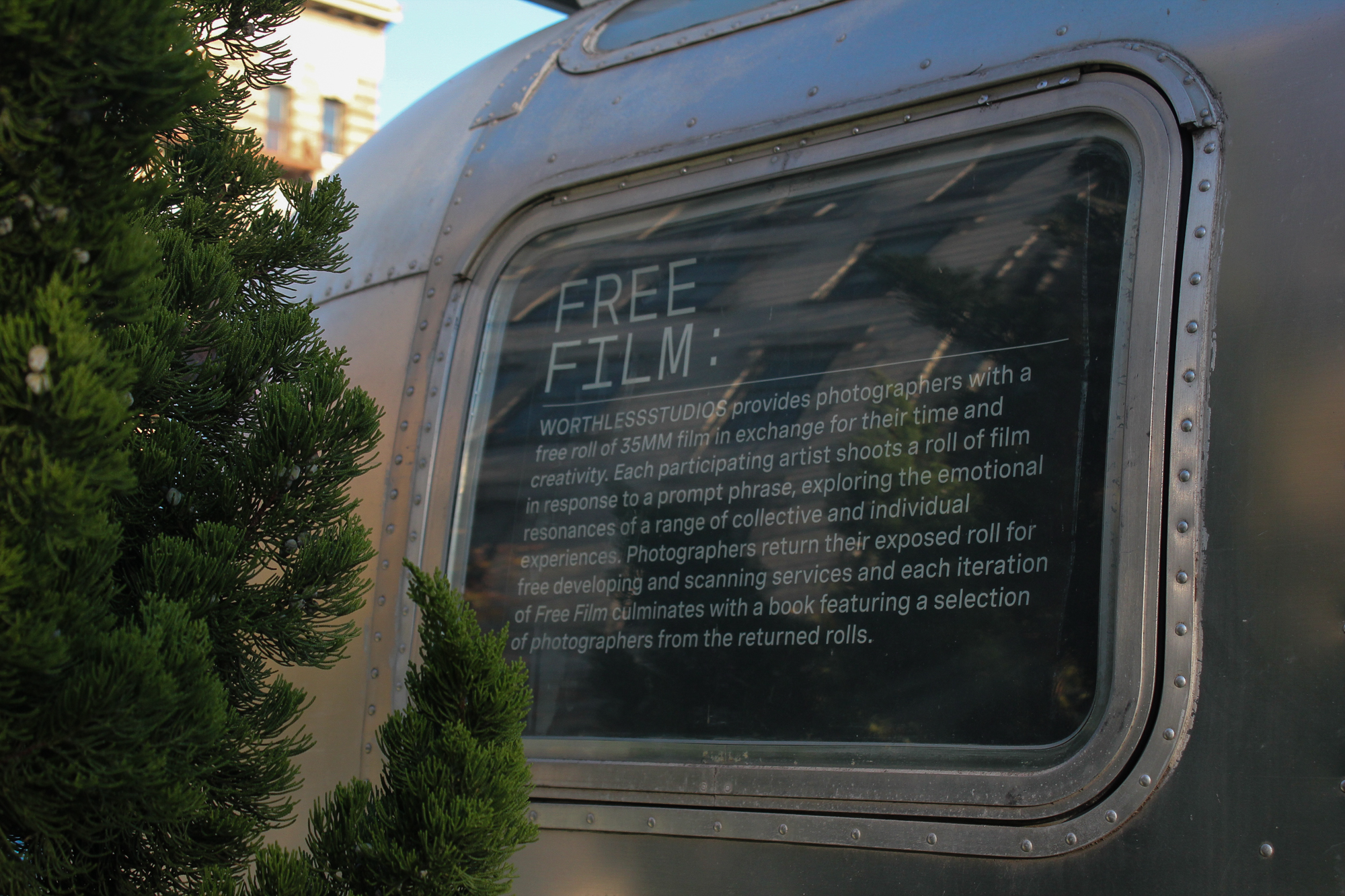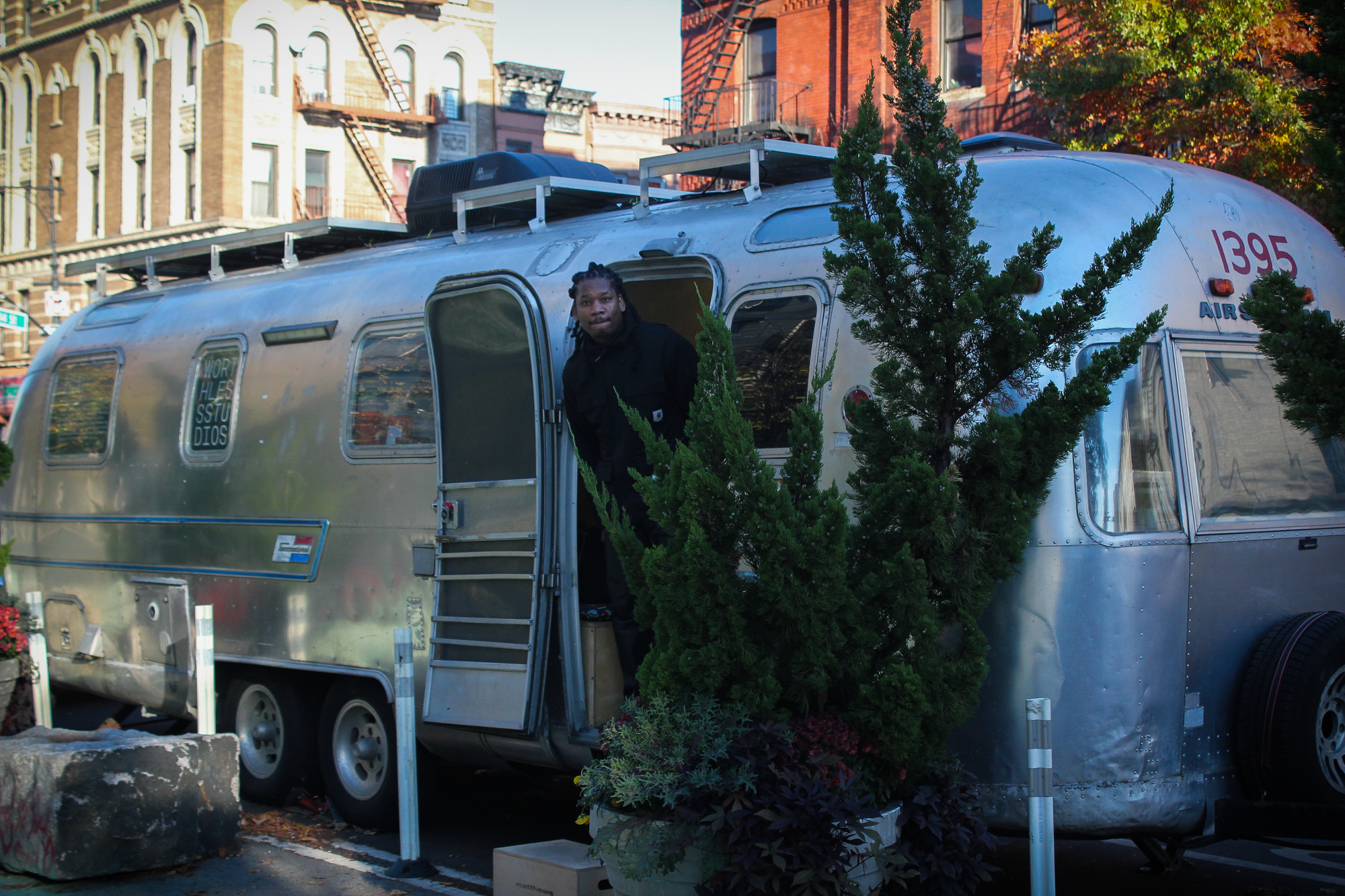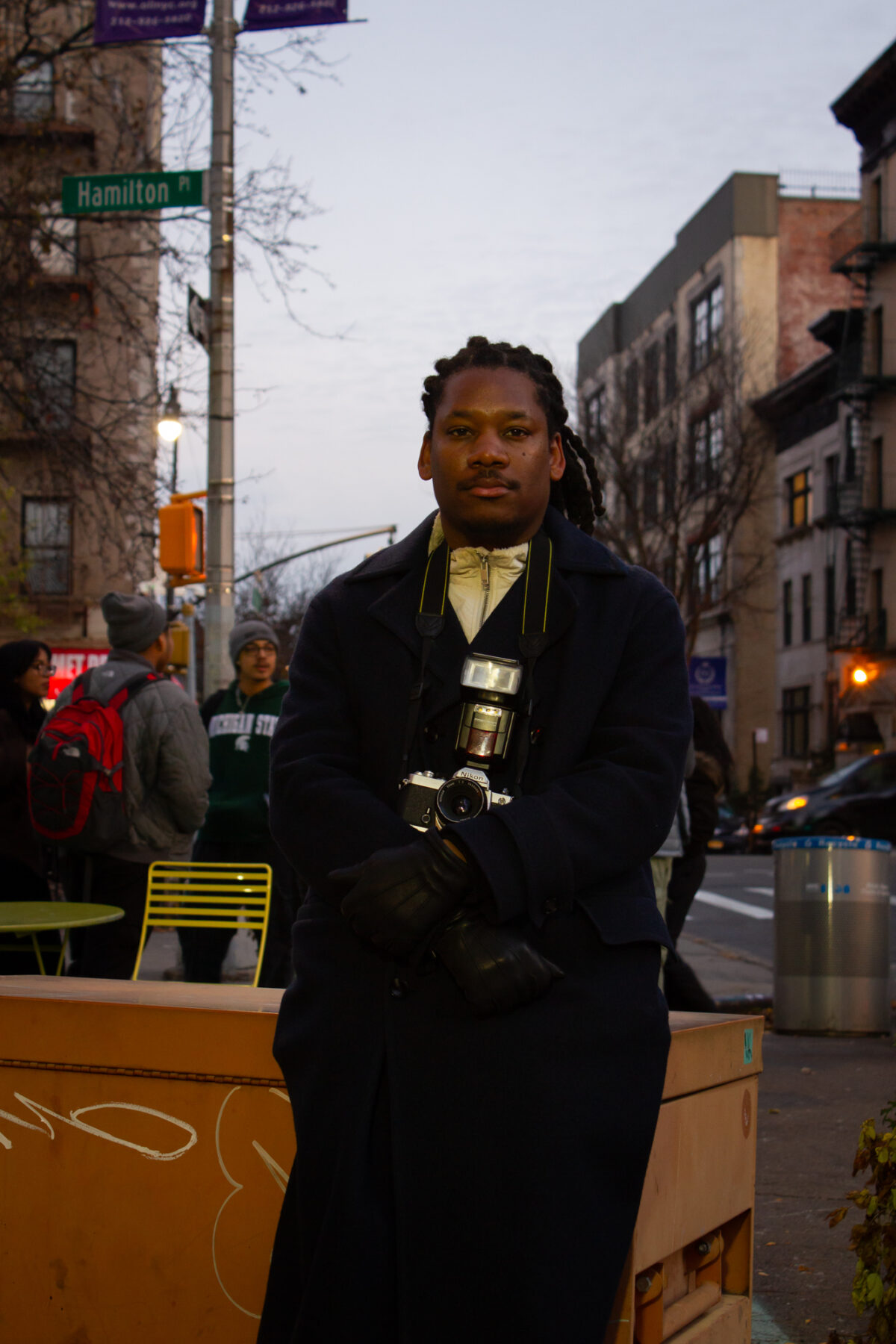
Credit: Jolie Tanner
On a crisp November afternoon, Kevin Claiborne and Carlos De La Sancha prepared 10 amateur photographers and their cameras for the first “photo walk” of Free Film: NYC’s Harlem residency. Throughout the month, the two leaders worked from the project’s Airstream trailer parked beside Johnny Hartman Plaza at West 143rd Street and Amsterdam Avenue. They loaned out Pentax cameras and distributed rolls of 35mm film to project participants eager to cover a one-square-mile area of the neighborhood on foot. Hand warmers were provided to counter the autumn chill.
Claiborne, the 34-year-old artist in residence, acted as tour guide, leading the photographers through his neighborhood. Members of the group paused along the way to photograph whatever caught their eye—such as the pink polka dot trash bags near James Baldwin Lawn, the discarded bathtubs that lined an alley off West 140th Street and a jack-o’-lantern impaled on a fence along St. Nicholas Terrace.
The goal of Free Film: NYC is to engage neighborhoods by exposing them to film photography and encourage residents to share their experiences through a camera’s lens.
“They grab a roll, take a creative approach to those 36 images, and bring whatever it is they see and take whatever they want to document in a creative project,” Claiborne said.
The project has attracted participants from beyond New York City. Marina Outwater, a seventh-grade teacher in Watertown, Connecticut, who leads her school’s photography club, drove to Harlem to take part in the photo walk.
“I have been following the Free Film project for quite some time, ever since I heard about their cross-country road trip,” Outwater, a New York City native who now lives in Connecticut, said. “I was excited to learn that the project was going to be centered in a variety of different neighborhoods,” she said. “I wanted to participate when it was in Red Hook recently, but I couldn’t. So, I was thrilled to finally participate in the Harlem photo walk, since this was a neighborhood I was unfamiliar with.”

Kevin Claiborne peers out of Free Film: NYC’s trailer in Harlem’s Johnny Hartman Plaza. (Credit: Jolie Tanner)
Most of the participants are seasoned photographers, while others are beginners, according to De La Sancha, who leads the program and is operations manager at WorthlessStudios, an artist community space in Brooklyn.
Free Film: NYC’s goal is to make film photography more accessible throughout the metropolitan area. The project began its fourth round last June.
Each residency lasts for one month. After the rolls of film are returned at the end of the month, Free Film: NYC develops the images through Picture House, a photo lab and darkroom in Chelsea that is collaborating on the project. Digital copies of the photos are sent back to each photographer free of charge. The New York City residences have included Red Hook, Brooklyn; the South Bronx; Sunset Park, Queens; and the Lower East Side and Harlem in Manhattan. The project concludes in East Williamsburg, Brooklyn, in March.
Each project begins with an open call through WorthlessStudio’s social media accounts for an artist in residence based in the neighborhood. One of the perks of the role is access to the workspace, which is highly sought after in the city. Claiborne was familiar with the initiative before applying for the position. His relationship with the project began in 2020 through an open call to photograph Black Lives Matter protests as part of his contribution to the final photobook.
“I participated and had a roll of film, and then when I submitted it, they had selected one of my images to be in their book,” Claiborne said. “After that, I just kept up with them and tried to stay on top of future initiatives they might be doing.”
The month-long role involves three photo walks and a certain number of hours of work per week in the Airstream trailer. Beyond that, planning events, operating the darkroom and managing relationships with partner organizations are done at the artist in residence’s discretion.
Claiborne is a native of Camp Springs, Maryland, which is just outside the Capital Beltway southeast of Washington, D.C. As a child, he often visited Harlem and has lived in the neighborhood for the past four years, while documenting its transformation primarily on black and white film. “It’s something that I feel deserves a critical eye,” he said. “I’m part of that new class of people coming into the area, compared to people who’ve been there for generations, so I’m trying to capture what I see as someone young and living in Harlem.”
He draws on his personal history as a key motif of his artwork. “The original reason why I started doing photography was actually because of my lack of ability to have a strong memory of my life experiences,” he said.

Claiborne at the Johnny Hartman Plaza during the Brotherhood Sister Sol workshop. (Credit: Jolie Tanner)
Claiborne first picked up a film camera at Syracuse University, where he was studying for his master’s degree in higher education. It was a new direction for Claiborne after completing an undergraduate degree in mathematics at North Carolina Central University, a historically black institution. He later moved to California and began developing his own images at a community darkroom. Claiborne came to New York to work on a Master of Fine Arts degree at Columbia University, which he completed in 2021. This past fall he taught film photography as an adjunct professor at Columbia’s School of Arts.
When the artist in residence role with Free Film: NYC became available, and along with it the workshops and Airstream trailer to work in, Claiborne pounced. “I haven’t seen any art opportunity that gives access to a darkroom, especially a mobile darkroom, from anyone,” he said.
The opportunity to spark creative passion in his community through youth workshops and local photo walks was another attraction of the job. Claiborne is an advocate for the accessibility of photography, notwithstanding the additional challenges of working with film. The process forces you to slow down “in a good way because the medium itself requires you to be more thoughtful and intentional,” he said. “There’s a limitation in terms of images per roll of film, there’s limitation because of the cost associated with the medium for analog versus digital.”
WorthlessStudios offers the month-long residency to local artists in the Airstream, which has traveled across the country. The studio’s founder, Neil Hamamoto, and the creators of Free Film, distributed their first 100 rolls of film at their Canal Street pop-up project in 2018, before switching to a mobile darkroom and taking it on the road the following year for Free Film: USA. The team toured 18 cities in four months, developing and scanning more than 35,000 negatives in the trailer. As a precursor to Free Film: NYC, the project documented lives and landscapes across the U.S. through the eyes – and lenses – of inhabitants.
Since its inception, the main purpose of the Airstream has been for it to travel as a fully functional darkroom. Hamamoto found the aluminum trailer, a 1973 Airstream Land Yacht, abandoned in a barn and in disrepair in Upstate New York.
The original team purchased the vehicle and, over the course of five months, refurbished it inside and out, while creating an office, darkroom and exhibition space.
De La Sancha, who has worked with Free Film for about a year, said he has been into art as far back as he can remember, whether it be writing, theater or photography. A native of Córdoba, Mexico, he began focusing on photography through classes while living in Berlin, and also in Oaxaca, Mexico, and at the Escuela Activa de Fotografía in Mexico City.
“I moved to Germany in 2011 and that’s where I learned how to work with black and white film,” De La Sancha said. “The first time I developed a roll and made a first print, I was so inspired. I felt something move in me.”
In Oaxaca, he took part in photo-related workshops, worked on photo printing and split his time between a darkroom in his apartment and a job as a printer for a photographer.
“I’ve always been interested in the creative side of life,” he said. “I’ve been privileged enough to be able to focus on that almost exclusively, which is great.”
Two years later, De La Sancha was living in New York and attending the International Center of Photography’s Creative Practices program. He landed at WorthlessStudios after responding to an open call for a darkroom technician. Initially, he helped out with whatever was missing or needed improving in the darkroom. He coordinated with other artists that had responded to open calls, mailed old negatives, scanned rolls of film and worked with Picture House, processing images.

De La Sancha at WorthlessStudio’s space in Brooklyn. (Credit: Jolie Tanner)
De La Sancha now oversees the entire Free Film initiative.
He spends the bulk of his time in the trailer while the project is in progress and squeezes in time at the studio. He is either talking to artists or potential partners, running the program’s social media, promoting the photo walks and opening days or reaching out to organizations to potentially partner with on future programs.
In November, Free Film: NYC joined with The Brotherhood Sister Sol, a Harlem-based youth organization, to lead analog and digital photography workshops and photo walks for middle school and high school students in the neighborhood.
Brotherhood Sister Sol has served local students since 1995 through mentorship and leadership activities. The after-school photography group empowers students by giving them the opportunity to depict their experiences in the community, according to Frank López, who leads the sessions. “I think it’s important to be able to tell your story, to feel empowered and inspired and celebrated for sharing your story,” he said.
López, 39, is an alumnus of the Brotherhood Sister Sol program, as is most of the group’s staff. He serves as the organization’s arts educator and resident film-maker. López grew up in Washington Heights, about 20 blocks uptown, and heard about the program from a friend when he was 16. López said he has benefited from the experience and the lasting connections it fostered.

López works with Brotherhood Sister Sol students during the film photography workshop in Johnny Hartman Plaza. (Credit: Jolie Tanner)
At a recent film photography workshop, Claiborne led 11 high school students on a late afternoon photo walk, catching the last light of the day. The group scattered around Johnny Hartman Plaza, snapping images of each other and turning to Claiborne or López when they needed help adjusting camera settings or coming up with new angles to photograph their friends. The teenagers were able to experiment with shooting manually in their groups of two and three before heading indoors for a presentation by the artist.
“Did you all have fun freezing your hands?” Lopez said as they made their way back upstairs in the Brotherhood Sister Sol space.
Claiborne gave an overview of his work and discussed how he switched from struggling in computer science classes to pursuing art. “I always knew I was creative but didn’t know you could do it as a job,” he said. “I thought being creative was something you did when you were older.”
After taking questions from the students, Claiborne prepared to leave. “Y’all are lucky,” he told the group. “I had nothing like this growing up.”
The students then critiqued each other’s photos projected on a screen.

A high schooler participating in the Brotherhood Sister Sol film photography workshop. (Credit: Jolie Tanner)
An introduction to the darkroom process would be their next session with Claiborne. The final workshop would be held in the WorthlessStudios trailer.
The next and final destination on the New York tour will be East Williamsburg, Brooklyn. The team at WorthlessStudios will curate the culmination of the project—a photo book and exhibition—in early 2024.
De La Sancha said he hopes each neighborhood continues to engage with film photography after the Airstream is driven away and the artist in residence is tasked with keeping the community connected through exhibitions and public art events.
“What I wish the community takes from us is the chance to connect, to communicate, to become more of a connected society instead of just different neighborhoods and people who do something here and there,” he said. “One thing that I find amazing about the project is that we don’t go somewhere and make it ourselves. We’re not like, ‘I’m gonna show you how your neighborhood looks.’ It’s like, ‘I want you to show me how you live here. Please share your reality with us,’ because we’re interested in seeing how the whole city is.”
Like other participants, Outwater, the seventh-grade teacher who joined the Harlem photo walk, is looking forward to seeing the results of their exploration of the neighborhood.
“I can’t wait to see my photos, and I hope that one of my images is good enough to be chosen for the upcoming exhibit or book,” she said. “I love the concept of this project and the way it inspires people, young and old alike, to pick up a film camera and document life in diverse locations.”
About the author(s)
Jolie Tanner, originally from Winter Haven, Florida, is a graduate student at the Columbia Journalism School.
Marine Saint is a British and French journalist and a graduate student at Columbia School of Journalism.



